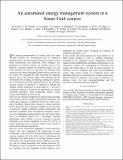| dc.contributor.author | Lopes, M. | |
| dc.contributor.author | Antunes, C. H. | |
| dc.contributor.author | Soares, A. R. | |
| dc.contributor.author | Carreiro, A. | |
| dc.contributor.author | Rodrigues, F. | |
| dc.contributor.author | Neves, L. | |
| dc.contributor.author | Jorge, H. | |
| dc.contributor.author | Gomes, A. | |
| dc.contributor.author | Martins, A. G. | |
| dc.contributor.author | Dias, L. | |
| dc.contributor.author | Pereirinha, P. | |
| dc.contributor.author | Trovao, J. P. | |
| dc.contributor.author | Monica, A. | |
| dc.contributor.author | Oliveira, M. | |
| dc.contributor.author | Breda, S. J. | |
| dc.contributor.author | Viegas, R. | |
| dc.contributor.author | Peixoto, P. | |
| dc.contributor.author | Livengood, Daniel James | |
| dc.contributor.author | Larson, Richard Charles | |
| dc.contributor.author | Leow, Woei Ling | |
| dc.date.accessioned | 2013-11-22T16:13:41Z | |
| dc.date.available | 2013-11-22T16:13:41Z | |
| dc.date.issued | 2012-05 | |
| dc.identifier.isbn | 978-1-4673-2004-7 | |
| dc.identifier.isbn | 978-1-4673-2003-0 | |
| dc.identifier.isbn | 978-1-4673-2002-3 | |
| dc.identifier.uri | http://hdl.handle.net/1721.1/82546 | |
| dc.description.abstract | The ongoing transformation of electric grids into smart grids provides the technological basis to implement demand-sensitive pricing strategies aimed at using the electric power infrastructure more efficiently. These strategies, also designated by demand response [1], already proved to be effective in altering patterns of electricity usage [2-6], and create benefits not only for end users (by lowering their electricity bill without degrading comfort levels), but also for the utilities (by managing the peak, flattening the aggregate demand curve, and meeting supply with demand) and the environment (by avoiding, or delaying, building new generation units and other network infrastructures). In fact, demand-sensitive pricing of electricity is expected to become the standard pricing mechanism in smart grids [3, 7, 8] and is considered essential to accelerate the deployment of variable renewable generation while maintaining electric system security and reliability at least cost [9]. | en_US |
| dc.language.iso | en_US | |
| dc.publisher | Institute of Electrical and Electronics Engineers (IEEE) | en_US |
| dc.relation.isversionof | http://dx.doi.org/10.1109/ISSST.2012.6227983 | en_US |
| dc.rights | Creative Commons Attribution-Noncommercial-Share Alike 3.0 | en_US |
| dc.rights.uri | http://creativecommons.org/licenses/by-nc-sa/3.0/ | en_US |
| dc.source | Prof. Larson via Angie Locknar | en_US |
| dc.title | An automated energy management system in a smart grid context | en_US |
| dc.type | Article | en_US |
| dc.identifier.citation | Lopes, M., C. H. Antunes, A. R. Soares, A. Carreiro, F. Rodrigues, D. Livengood, L. Neves, et al. “An automated energy management system in a smart grid context.” In 2012 IEEE International Symposium on Sustainable Systems and Technology (ISSST), 1-1. Institute of Electrical and Electronics Engineers, 2012. | en_US |
| dc.contributor.department | Massachusetts Institute of Technology. Engineering Systems Division | en_US |
| dc.contributor.approver | Larson, Richard Charles | en_US |
| dc.contributor.mitauthor | Livengood, Daniel James | en_US |
| dc.contributor.mitauthor | Larson, Richard Charles | en_US |
| dc.contributor.mitauthor | Leow, Woei Ling | en_US |
| dc.relation.journal | Proceedings of the 2012 IEEE International Symposium on Sustainable Systems and Technology (ISSST) | en_US |
| dc.eprint.version | Author's final manuscript | en_US |
| dc.type.uri | http://purl.org/eprint/type/ConferencePaper | en_US |
| eprint.status | http://purl.org/eprint/status/NonPeerReviewed | en_US |
| dspace.orderedauthors | Lopes, M.; Antunes, C. H.; Soares, A. R.; Carreiro, A.; Rodrigues, F.; Livengood, D.; Neves, L.; Jorge, H.; Gomes, A.; Martins, A. G.; Dias, L.; Pereirinha, P.; Trovao, J. P.; Larson, R.; Leow, W. L.; Monica, A.; Oliveira, M.; Breda, S. J.; Viegas, R.; Peixoto, P. | en_US |
| dc.identifier.orcid | https://orcid.org/0000-0003-2776-4900 | |
| mit.license | OPEN_ACCESS_POLICY | en_US |
| mit.metadata.status | Complete | |
